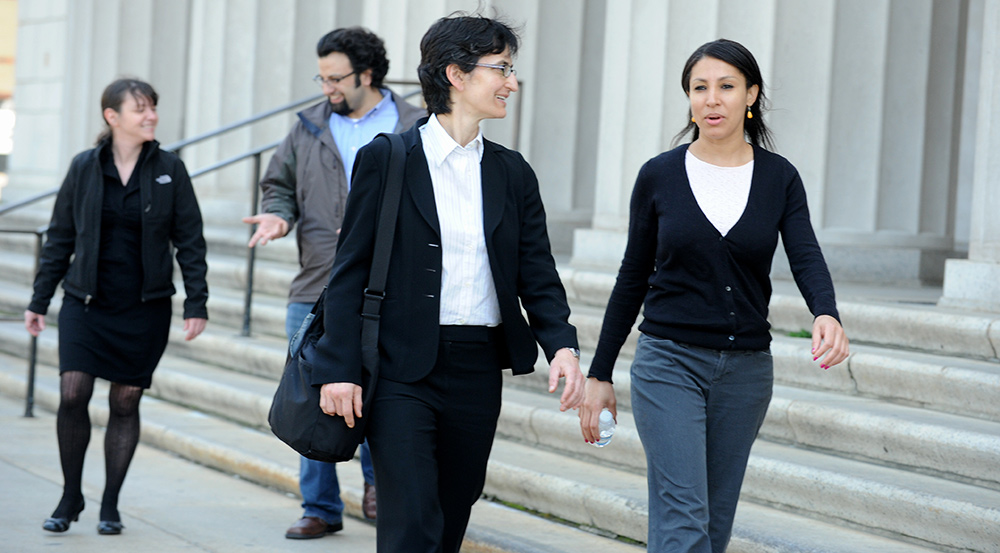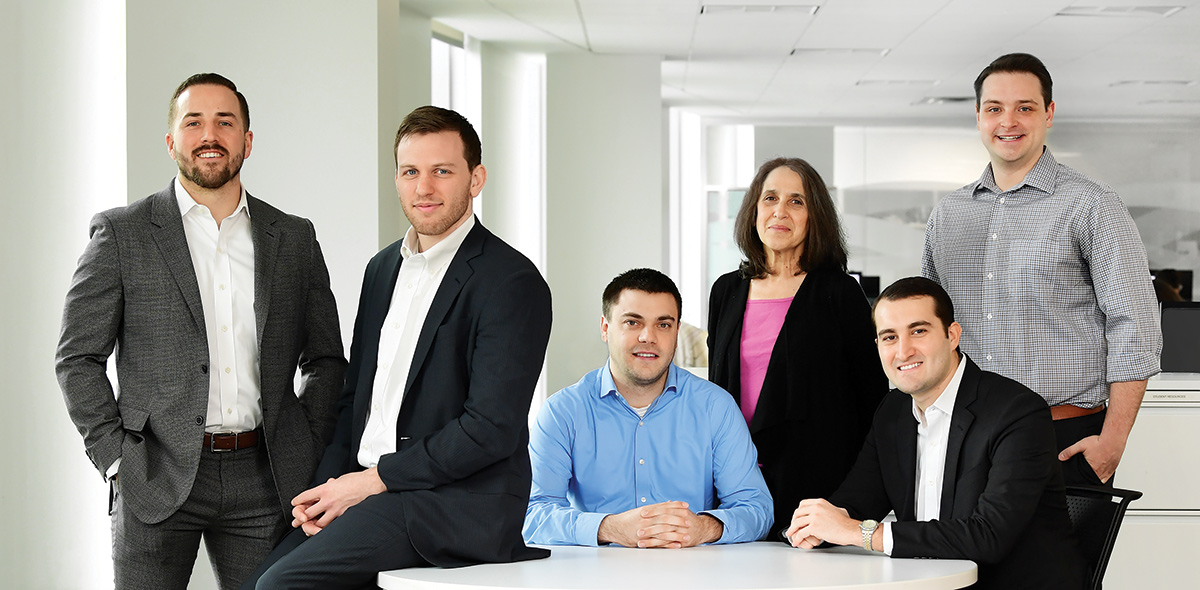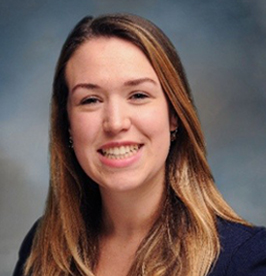

ou might think that people being sued for consumer debt are victims of their own bad habits—namely, irresponsible overspending. But stop by the Bronx Civil Courthouse on a Thursday afternoon and a different picture emerges.
Court may not be in session, but the rooms will be filled with litigants in consumer debt cases, along with lawyers, law students, and other volunteers with the Bronx Civil Legal Advice and Resource Office (CLARO), a clinic that advises ordinary folks being sued for debt that is run by Fordham Law School’s Feerick Center for Social Justice.
“Most of the people who come [seeking help from CLARO] are low- and moderate-income New Yorkers, many of whom are working more than one job, whose wages just haven’t been able to keep up with the cost of living,” explains Dora Galacatos ’96, adjunct professor of law and executive director of the Feerick Center. Some are victims of predatory and fraudulent lending schemes. Many of them are being pursued by debt collectors who use sketchy—and often illegal—means to bring suits and pressure consumers into making payments they may not in fact owe. More than a few learn they have a judgment against them long after the case was filed and find out only when their wages are garnished or they are unable to withdraw money from an ATM.
Karuna Patel, deputy director of the Feerick Center, is the newest member of the Feerick Center team. Patel, who brings 15 years of experience in economic justice and consumer issues, was involved in CLARO when the program began in 2005. Yet a recent visit to a Bronx session was still eye-opening and emotional for her. “It’s incredibly inspiring to see what this program has become,” she says. “There were students doing intakes, lawyers helping litigants at desks, experts and translators roaming around and jumping in wherever needed. It felt so organic the way everyone was working together for a common goal, which was to help people and give them access to justice.”

Without CLARO, the clinic’s clients would have nowhere to turn, says James Daw ’74, one of the many Fordham Law alumni who volunteer in the Bronx every Thursday. “Even if they could afford a lawyer, they would have a very hard time finding one because these cases aren’t cost-effective for a private firm. As a result, most would likely end up parting with their last dollars out of fear and a desire,” he says, “to do the right thing, never realizing that there are laws designed to protect them from unfair collection practices.”
Since the mid 2000s, hundreds of thousands of New Yorkers have been sued in collection cases, with filings peaking in 2008, when more than 300,000 debt collection cases were brought in New York City’s Civil Court alone. Now, the numbers are on the rise again. Over the past three years, consumer credit filings have more than doubled, from roughly 46,000 in 2016 to more than 100,000 in 2018. “A lot of social science research shows that too many Americans are one calamity away from financial disaster,” notes Galacatos. Stagnating wages and thin margins have left many New Yorkers vulnerable to subprime lending—i.e., credit cards with abusive terms that can trap them in a vicious debt cycle. “Often, people who come to CLARO say, ‘I don’t understand how I could possibly owe $1,200 when there was a $500 cap on this credit card,’ which gives you a sense of the ballooning effect of interest rates, late fees, and penalties,” she explains.

Despite reforms in the debt collection industry, there are still agencies that buy up debt from original creditors for pennies on the dollar, then hire debt collection law firms to file cases in bulk, frequently based on inaccurate information. “Many law firms that specialize in debt collection still make their money by doing a high-volume practice,” explains Marcella Silverman, a clinical associate professor of law who teaches at Fordham Law’s Consumer Litigation Clinic (CLC). “When 11 lawyers at one debt collection firm bring more than 42,000 cases in a year, they can’t look over anything too carefully or concern themselves too much with whether process servers are really serving papers,” she notes. Indeed, a problem known as “sewer service” still exists—when process servers throw papers notifying a person of a lawsuit in the garbage and then lie to the court that they were served—leading to default judgments that can result in people’s wages being garnished and their bank accounts frozen.

This dodgy business model works for one reason: “Just a tiny percentage of consumer defendants have lawyers,” says Silverman. In contrast, “Plaintiffs in consumer debt cases are represented by lawyers nearly 100 percent of the time. That’s more than a little bit of a mismatch.”
Students volunteering for CLARO and enrolled in the CLC are working hard to remedy this imbalance. Since 2008, Galacatos, Wilma Tamayo-Abreu (the Feerick Center’s program and administrative coordinator), and the rest of the CLARO team have logged close to 35,000 volunteer hours. During that time, they’ve done more than 22,000 consultations and served nearly 14,000 unique individuals in the Bronx, Manhattan, and Staten Island, meeting with and advising pro se defendants (aka those who represent themselves) on the court process, reviewing case files, and preparing court papers. “I’ve learned more about civil procedure and client communication at CLARO than I could have in any classroom,” notes Ciera Wilson ’20, who has been volunteering with CLARO for nearly three years. “Every week, I sit down with people who need my help and practice my skills as a lawyer.”
Marisa Menna ’13 stumbled onto CLARO as a 1L—and never looked back. “Growing up in a working-class family, I could identify with the clients coming in,” says Menna, who was also in Silverman’s CLC clinic. “And I was just so taken with the work and how much help the experts and other volunteers were able to give people, that I thought, this is what I want to be doing.” Her experience with CLARO, CLC, and other public service initiatives at the Feerick Center paved the way for her stint at the Consumer Financial Protection Bureau as well as her current gig as a senior staff attorney in the consumer law unit of the nonprofit CAMBA in Brooklyn. “I’m grateful to be doing the work I loved doing in law school.” So much so that Menna serves as co-counsel with Silverman’s CLC students on several cases, and as an expert at CLARO.
Students in Silverman’s CLC also get hands-on experience providing full legal services to low-income consumer defendants in federal, state, and local trial and appellate courts. Clinic students take primary responsibility for every aspect of a case, including interviewing and counseling clients, researching relevant law, drafting motions and briefs, and appearing in court to argue and try cases. Thomas Kendris ’20 is currently working on a case (with Menna as co-counsel) in which a woman was asked by her ex-husband to cosign a loan for a used BMW. Years later, when her ex defaulted on the loan, she discovered she was the sole signatory. Now, she is being sued for more than $16,000, which is “money she doesn’t have, for a car she never meant to own, never wanted, and never drove,” explains Kendris, who has found several deficiencies in the case. One is that the loan contract violated the Truth in Lending Act, which says that the terms must be clearly and legibly stated. The type on his client’s contract, he says, is fuzzy; and the dollar amounts were printed over other material, making them hard to decipher. Another document sent by the lender grossly overinflated the amount Kendris’ client needed to pay to reclaim the car. On top of that, he plans to argue that the dealer engaged in misconduct when he, along with the ex-husband, swindled his client into signing. “Some cases are so factually complicated and legally complex that there is no way a person can win without being fully represented by a lawyer,” notes Silverman. “Those are the cases we bring back to the clinic.”
Silverman thinks Kendris’ chances of prevailing are good. “Once my students push back with their well-researched and well-written answers, advancing meritorious defenses and counterclaims, plaintiffs in these auto loan cases often decide it’s not worth pursuing a case they’d have won against an unrepresented consumer,” she says. Adds Kendris, “It’s amazing what a difference having access to a lawyer can make.”
Silverman’s students have also been instrumental in helping reform consumer law. One win she is especially proud of is Portfolio Recovery Associates v. King, where her students wrote an amicus brief to the New York Court of Appeals in support of a pro se appellant that led to a change in the way banks could sue people for credit card debt. King, a New York resident, was being sued for debt on a credit card issued by a Delaware bank, well past that state’s three-year statute of limitations. Silverman’s students argued that instead, the statute of limitations of the state where the credit card issuer is based should apply (i.e., Delaware’s three-year statute), rather than New York’s six-year statute of limitations. “Much of the Court of Appeals’ decision looked a lot like a cut-and-paste of the students’ appellate brief,” Silverman says. It was a big win for King, for Silverman’s clinic, and for consumers throughout New York state. “There had been a huge number of cases being brought in New York from banks headquartered in other states, long after the ability to sue in their own states had expired,” says Silverman. “That makes it harder for consumers to defend themselves, because when so much time has passed, they may not even have the relevant paperwork. Fortunately, this case put an end to that practice.”
Wilson says she will never forget helping an elderly woman on disability who came to CLARO in Manhattan “freaking out,” after getting a letter stating that a judgment had been made against her more than 15 years earlier, and that she now owed a debt of about $20,000. “She kept saying, ‘I don’t know how this could be—I’m not a big spender. How am I going to be able to live and pay this back?’” Wilson explained to the woman that a volunteer lawyer would meet with her and most likely explain that her disability income was exempt from debt collection. “She was so relieved, she started crying,” recalls Wilson. “I got emotional, too, because she reminded me of my grandmother.”
Experiences like that one remind Wilson why she went to law school in the first place. “When you’re reading textbooks all day, fighting to get a good GPA and for jobs at the best law firms, it’s easy to lose sight of why you’re doing it,” she says. “CLARO reminds me that we’re learning the law so we can empower people. That’s the whole point of becoming a lawyer.”
